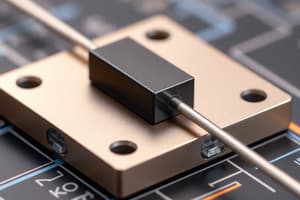Podcast
Questions and Answers
What is a characteristic property of a semiconductor?
What is a characteristic property of a semiconductor?
The resistivity is between that of a good conductor and a good insulator.
How does the resistance of a semiconductor change with an increase in temperature?
How does the resistance of a semiconductor change with an increase in temperature?
The resistance decreases with an increase in temperature.
What is the effect of thermal agitation on electrons in a semiconductor?
What is the effect of thermal agitation on electrons in a semiconductor?
Electrons gain energy and break bonds, allowing for current to flow.
What is a positive hole in a semiconductor?
What is a positive hole in a semiconductor?
What is the direction of flow of electrons and positive holes in a semiconductor?
What is the direction of flow of electrons and positive holes in a semiconductor?
What is the difference between intrinsic and extrinsic conduction in semiconductors?
What is the difference between intrinsic and extrinsic conduction in semiconductors?
What is the purpose of doping a semiconductor?
What is the purpose of doping a semiconductor?
What is the difference between N-type and P-type semiconductors?
What is the difference between N-type and P-type semiconductors?
What is a thermistor and how does it respond to changes in temperature?
What is a thermistor and how does it respond to changes in temperature?
What is the effect of doping on the number of free electrons and holes in a semiconductor?
What is the effect of doping on the number of free electrons and holes in a semiconductor?
What is the primary function of a diode in an electric circuit?
What is the primary function of a diode in an electric circuit?
How does the resistance of a Light Dependent Resistor (LDR) change when light shines on it?
How does the resistance of a Light Dependent Resistor (LDR) change when light shines on it?
What is the depletion layer in a p-n junction, and how does it behave?
What is the depletion layer in a p-n junction, and how does it behave?
What is the junction voltage in a p-n junction, and what causes it?
What is the junction voltage in a p-n junction, and what causes it?
What is the main difference between the p-type and n-type regions of a p-n junction?
What is the main difference between the p-type and n-type regions of a p-n junction?
What is the purpose of a diode in a rectifier, and how does it achieve this purpose?
What is the purpose of a diode in a rectifier, and how does it achieve this purpose?
Describe the difference in the behavior of a diode when connected in forward bias and reverse bias.
Describe the difference in the behavior of a diode when connected in forward bias and reverse bias.
What is the principle behind the working of a Light Emitting Diode (LED)?
What is the principle behind the working of a Light Emitting Diode (LED)?
What is the main function of a rectifier in a power supply, and how does it achieve this?
What is the main function of a rectifier in a power supply, and how does it achieve this?
How does the biasing of a diode affect its ability to conduct electricity?
How does the biasing of a diode affect its ability to conduct electricity?
What substance is commonly used to create a p-type semiconductor?
What substance is commonly used to create a p-type semiconductor?
What substance is often used to create an n-type semiconductor?
What substance is often used to create an n-type semiconductor?
What is the significance of the junction voltage in a p-n junction diode?
What is the significance of the junction voltage in a p-n junction diode?
How does the flow of current through a diode change when its biasing changes from forward to reverse?
How does the flow of current through a diode change when its biasing changes from forward to reverse?
What is the role of a diode in a rectifier, and how does it achieve this role?
What is the role of a diode in a rectifier, and how does it achieve this role?





